---------------------------------------
Nearly one out of every 100 people living in Lamb County, Texas, died of COVID-19, one of the highest death rates in the nation. But in June 2022, more than two years after the start of the pandemic, many residents in the rural towns making up the panhandle county say things are back to normal. At a fundraiser for a Catholic church in Olton in the northeast part of the county, local families had set up stands selling gorditas and aguas frescas, and a live band belted out Tejano crowd pleasers while couples danced. Javi Lopez, 17 at the time, told me that people were comfortable gathering in groups now. Some of his friends had lost parents and other family members to the virus. “Now they’re better,” he said. “They cope with it.” He was standing a few feet away from where Linda Casares had been watching the performance. Two of her brothers died in the summer of 2020. She still cries when she talks about them.
[time-brightcove not-tgx=”true”]
I first came to report on the pandemic in Lamb County in the winter of 2020-2021. Now, with deaths slowing and the pandemic slipping out of the public consciousness a year and a half later, I was back to write about what moving on looks like here—if such a thing is even possible. It’s a topic that defies easy explanations. For some people, the lucky ones, it’s like nothing ever happened. For many others, nothing will ever be the same. Some of those who died were pillars of the local community, and their loss has further crippled towns that already seemed to be fading into the endless, empty landscape. Many people continue to believe conspiracy theories that circulated during the pandemic, that the virus was all a hoax, or that it was never as bad as health authorities made it out to be. Others are still angry about what they’ve gone through—about the mothers, husbands, children they will never see again. But amid tides of contradictory news and misinformation, many have little idea of who to blame.
There are many places like Lamb County around the country—poor, rural towns, susceptible to misinformation, which were suffering even before the pandemic, and have now taken another body blow. What happened here is typical of a broader, little-noticed disaster across flyover America. These also weren’t the only regions that suffered—the pain, the losses, the lingering division left by the pandemic can be found almost anywhere in the country. In Lamb, the permanent effects are just more visible, a reminder of the magnitude of what we’ve lost, and how little we’ve reckoned with it.
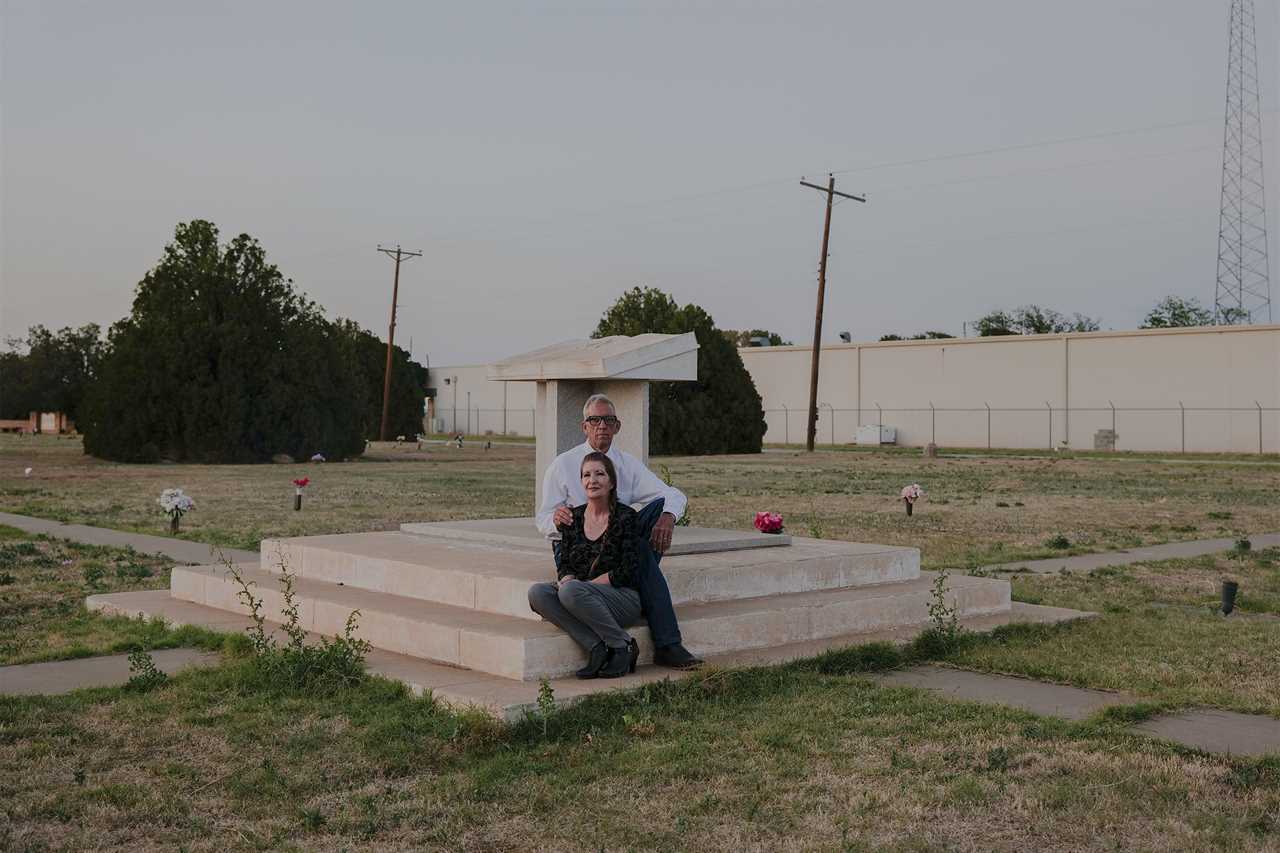
September Dawn Bottoms for TIMERhonda and Gary Yesel say they buried more than a hundred victims of the coronavirus in their cemetery outside Littlefield, Tx, working even when they were ill with COVID-19. “Death doesn’t stop,” Rhonda says. “If we hadn’t worked, we’d probably have bodies stacked up at the gate.”
Gary and Rhonda Yesel, 61 and 55, own a cemetery outside Littlefield, Lamb’s county seat. During the pandemic, they buried more than a hundred bodies here. Gary’s mother was one of them. Many others had been their friends. They took me out to see the graves in 2021. The land was perfectly flat, with iron grave plaques flush with the ground. Scabs of overturned dirt marked the graves from recent months—one belonged to a prominent member of the local Baptist congregation, another to a Vietnam veteran who had worked in Littlefield’s former denim plant. “We’re really not allowed to fall apart during services, because we’re there for the people to lean on and to hold everything together,” Gary said. “But that doesn’t make it any easier.”
Back in early 2020, many people here thought the pandemic might pass them by. Cities like New York and Los Angeles were reporting mass deaths—but these farming towns only had a handful of COVID-19 cases from March to May 2020. Then, in June, more cases started trickling in. By July, they were reporting dozens every week. Deaths followed, with some people dying at local hospitals, and others succumbing to the virus at home, suffocating while they slept. Nearly a third of one nursing home’s 67 residents died from the virus. Local papers printed multipage obituary sections, and the Yesels worked 18-hour days to handle the bodies. By the summer of 2022, the virus had killed nearly 1 out of every 100 people in the county—123 deaths for about 13,000 residents. The death rate was one of the highest in the country, and three times that of the nation as a whole.
For those who didn’t lose friends or family to COVID-19, it can be easy to think of deaths during the pandemic as discrete events, a weekly figure erased and replaced with another number the following week. But for those who lost loved ones, the body in the ground is only the beginning. For them, a death is both an event and an absence, a continuous reverberation of loss, which they relive over and over.
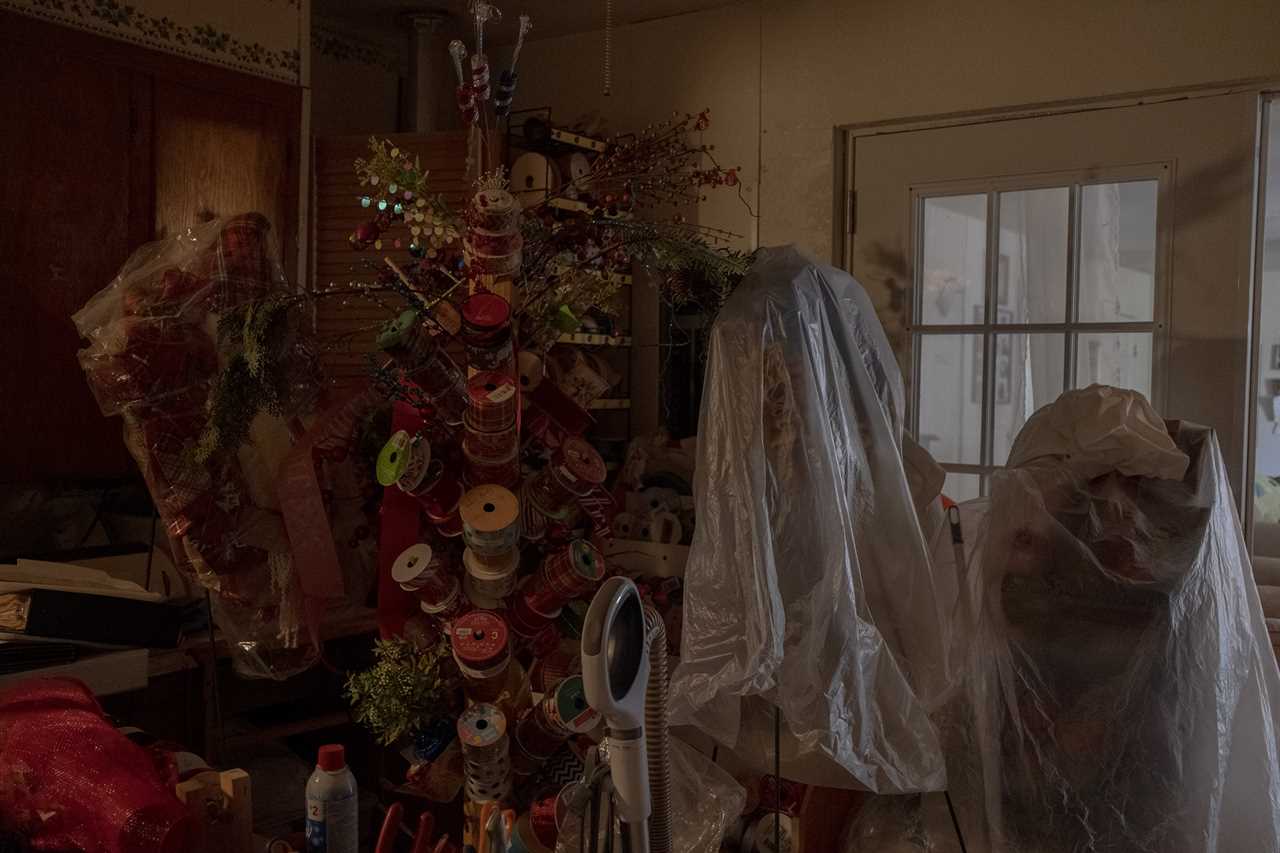
September Dawn Bottoms for TIMERibbons and decorative wreaths remain as Joanie Mosqueda left them in her home in Earth, Tx. She died in December 2020.
Al Mosqueda, 69, lost his wife Joanie to COVID-19 in December 2020. He still talks to her every day and keeps dozens of decorative wreaths that Joni had made before she died covered with sheets of clear plastic to keep the dust off. “All that was touched by her,” he says.
Amelia Zamora of Olton, Casares’s sister, found their brother Robert, 61, dead at home in the summer of 2020, with a lemon and cough drops by his bed. “They say that when you lose somebody, it gets easier [over time],” she says. “I think it gets harder … You never get to hear their laugh. You never get to experience the joy that he brought into our lives. He’s gone.”
Shawna Wagley, 45, a funeral director in Littlefield, keeps finding herself expecting her friend Charles Heffington to drop by the funeral home like he used to, even though she prepared his body for burial. She cried when she talked about him. “He used to call me ‘princess,’” she says.
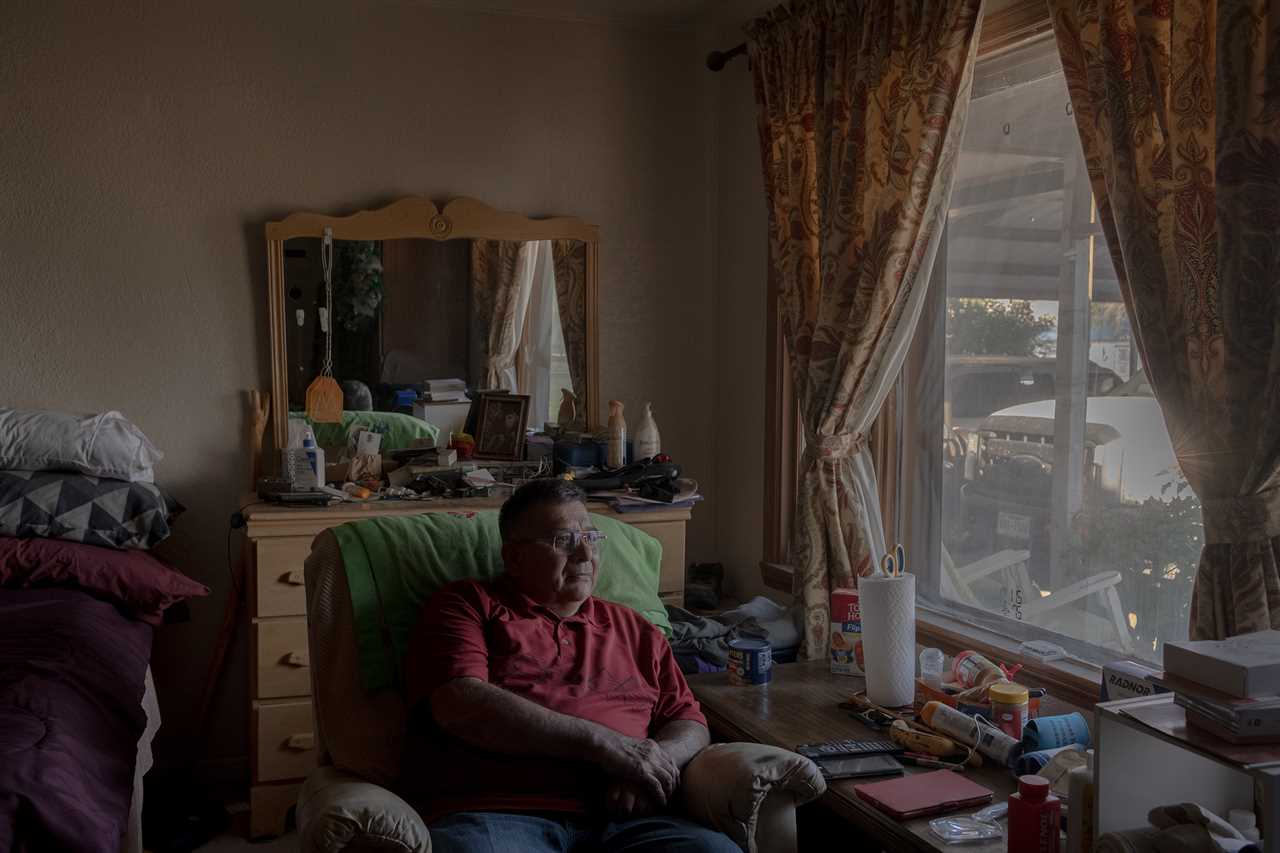
September Dawn Bottoms for TIMEAl Mosqueda says he still talks to his late wife Joanie. “I tell her that one of these days I’m going to push your buttons in heaven,” he says. “But I’ve learned my lesson. I won’t do it the way I did here.”
Lamb County’s pandemic death rate is an outlier: it’s the 8th highest in the nation as of March 2023, excluding counties with fewer than 2,500 people. But it’s representative of the quiet catastrophe in rural America. Like in Lamb, these are regions where populations have been aging and shrinking for years, while jobs and other opportunities have dwindled. Rural Americans tend to be older and in poorer general health than people living in urban areas, and decades of disinvestment have left many rural areas with little access to medical care, while high proportions of the people in them suffer from chronic diseases like diabetes, all of which have made them more vulnerable to COVID-19.
Rural Americans also tended to be more susceptible to vaccine misinformation. As vaccines were first becoming available in early 2021, 35% of rural respondents in a Kaiser Family Foundation survey said they wouldn’t get the shots, compared with 26% of urban dwellers. As antivaccine sentiment spread in conservative media and on social media platforms like Facebook, the disparity worsened. As of early 2023, 35% of rural Americans had still never received a single dose of the COVID-19 vaccine, compared with just 15% of people in cities.
The result has been a widening cumulative death rate in America’s rural regions. In October 2021, rural America had a total death rate about 24% higher than that in the cities, according to the Centers for Disease Control and Prevention. A year later, after the Omicron wave, the number had shot up to close to 40%, and one out of every 250 rural Americans was dead. “We took the population most at risk for COVID-19, and we ran them through a meat grinder over the last three years,” says Alan Morgan, head of the National Rural Health Association. “The result has been just devastating”
Some of those deaths can resonate across an entire community. Almost everyone in the town of Olton knew Chris Jones, 53, the local barber. He lived alone, but several households considered him part of what he called his “family by heart,” inviting him over for birthdays, Thanksgivings, and Christmases, and bringing him along on family vacations. He caught the coronavirus in late November 2020. “Have no idea where I got it,” he wrote on his Facebook page. “Keep me in your prayers. Guess I will see you in two weeks.” Hundreds of people responded to the post, wishing him a speedy recovery. Soon he began having trouble breathing. Friends in town prayed for him. He went to the hospital on Dec. 5, and by Dec. 7 he was wearing an oxygen mask. “I appreciate your calls,” Jones wrote online. “Keep the prayers coming.” The next day, he was moved to an intensive care unit. “Not doing great with Covid pneumonia,” he wrote on Dec. 8. “Rest and quiet are best right now. I love you all.” Four days later he died.
“We thought he’d be out for a little bit,” says Tammy Smith, a close friend. Jones had been like a big brother to her husband Charlie. “You talk to someone whose 90-year-old mother who has heart problems goes to the hospital and comes home. Why didn’t Chris? It doesn’t make sense.”
All over town, others continue to mourn his death. Jones drove a truck that made a distinctive engine noise, and people all through town knew the sound. Someone else drives the truck now, but Laurey Riney, one of Jones’ friends, still perks up when she hears it, only to remember again that he’s dead. More than a year and a half after Jones’s death, Michael Ramage hadn’t let anyone move into the apartment he used to rent to Jones, nor had he removed a note that a friend taped the door when Jones was sick. It said “Get well soon.”
On a hot day in June 2022, I was standing in the lobby of the Best Western Littlefield Inn and Suites, waiting for Rhonda and Gary Yesel to pick me up. There was a television on: Tucker Carlson monologuing on the House Jan. 6 committee with mesmerizing rage. I walked outside. It was painfully bright, and the wind was blowing. The hotel was on the edge of town, and trucks screamed past on the farm-to-market road into miles of empty farmland. The jingle of an ice cream truck sounded from the street. A man with a white goatee was talking on a phone nearby. “I told her to go ahead and call the cops on me,” he said. “Frankly,” he added, “I hope the bitch dies. I hate to say it.”
There’s an alien beauty to these parts—towns spaced like islands in an ocean of land, abandoned farmhouses that seem to beckon across the grass, the sheer weighty solitude one feels pulling off a road and looking around to realize that there is no one, anywhere, for as far as you can see. For hundreds of years, these high plains were the homeland of the Comanche Indians, known to encroaching white settlers for their skill with horses, and their ruthlessness in warring and raiding. Only after a series of bloody encounters did the U.S. military force the last Comanche bands onto reservations in 1875. White people began settling the region slowly at first—it has few rivers and inconsistent rainfall, which made it difficult to farm. A vast freshwater aquifer lay under the soil, but early farmers had no reliable way to access it. Then, after pumping technology began to improve in the early 1900s, farmers started drilling, pulling up water like oil prospectors, and towns, roads, courthouses, and schools sprung up, built with the riches that farmers were drawing from beneath the land.
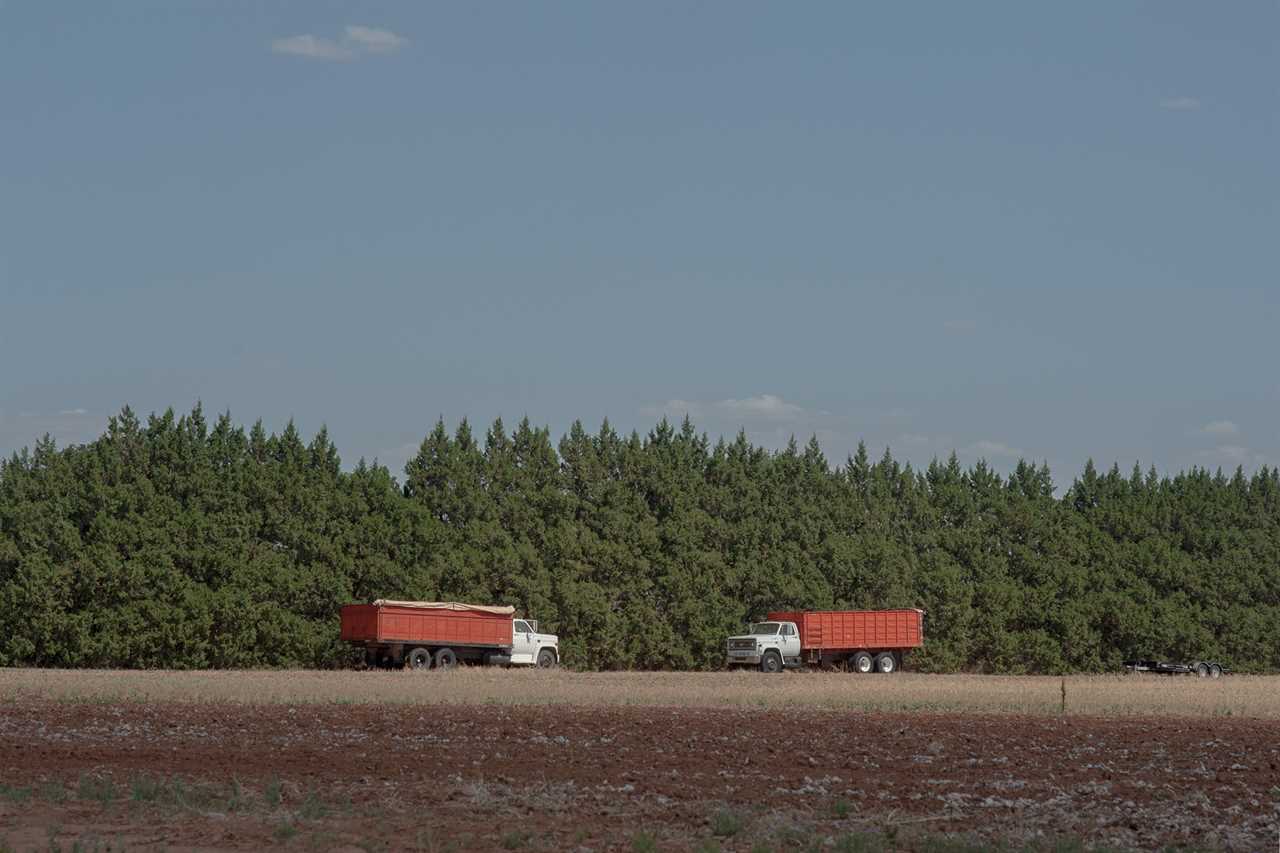
September Dawn Bottoms for TIMEAgriculture drives the economy of West Texas. Recent years have been hard for local farmers.
Many people here trace their ancestry back to that wave of settlement. Gary Yesel’s grandfather stepped off a train in Littlefield in 1916, when the town was little more than a train station and a water tower. “Our family basically started this town,” Gary’s grandson Easton, 10, told me at a local Mexican restaurant, where we were eating after Gary and Rhonda picked me up from outside the hotel.
These communities are close. Neighbors check on neighbors, a tendency people say can be traced back to the days before cars and phone lines, when the next farmstead was likely the only place to turn for help—the Yesels, for instance, took about 40 minutes to make the rounds in the restaurant and greet everyone they knew. When people got COVID-19 around here, neighbors would leave home-cooked meals for them on the front porch. After Jones, the barber, died, his friend Riney found several Thanksgiving meals in his fridge, dropped off by different families before he went to the hospital.
The racial dynamics of these communities are a holdover from that time too—white people tended to own the land here, and Hispanic people would work it. In Olton, white people still own many of the nicer houses on the northwest side of town, and poor Hispanic people live on the south side, some in corrugated iron shanties. Rene Amaya, 47, grew up on the south side of Olton, and he says Hispanic families tend to be more insular than the white ones. He lost his mother and two siblings in the pandemic, and the grief was mostly confined within a tight family circle. Part of that is because Amaya didn’t post about the deaths on social media. But though a lot of people say the difficulty of the pandemic brought people together, Amaya thinks his town’s grief is as segregated as everything else. “You talk to the white community and they’re like, ‘Oh, Chris Jones died, and Kevin Blount,’ … and those [deaths] are devastating,” he says. “But then you ask those same white people about Hispanic people passing, and they don’t know, and it’s not devastating.”
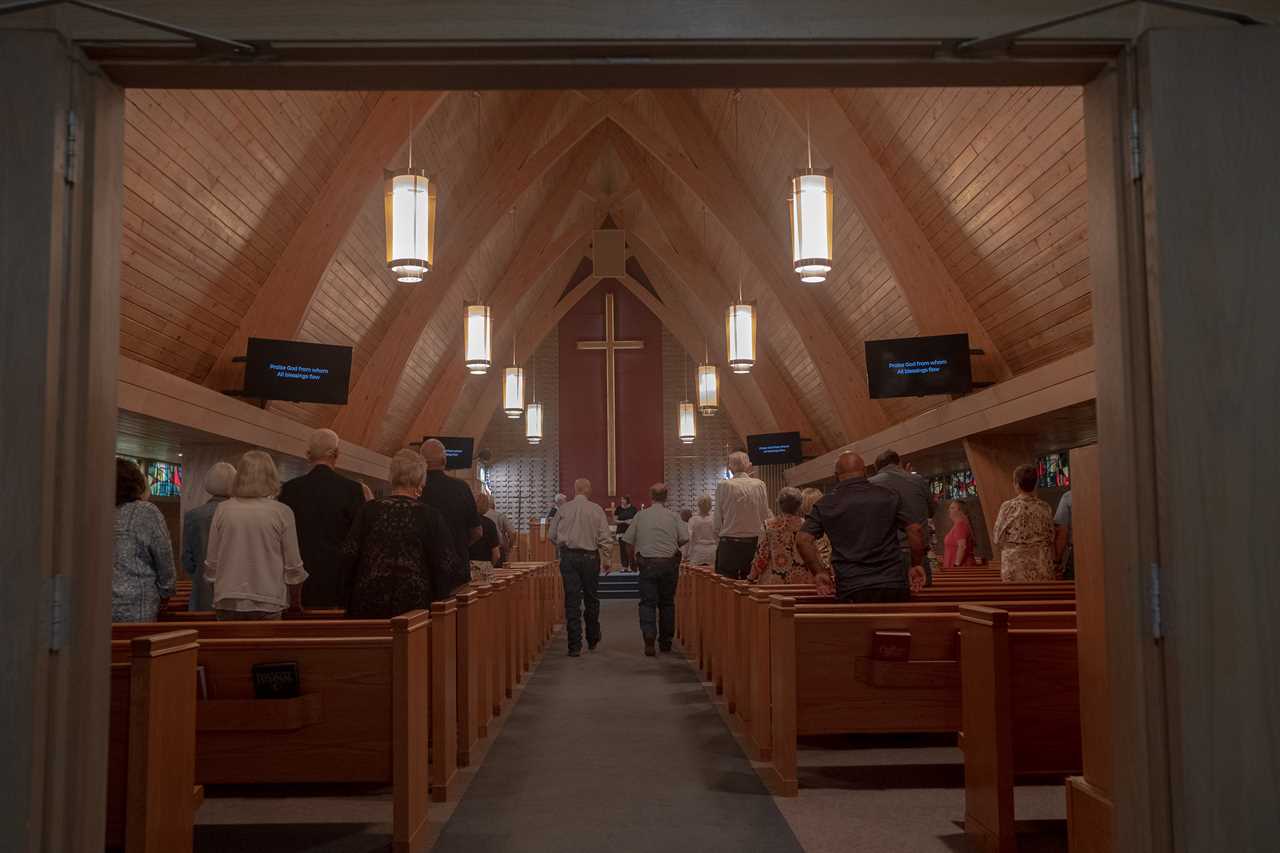
September Dawn Bottoms for TIMESome people are concerned about how politics and church have become intertwined in these towns. “It’s unsettling to me the way the Christian faith got almost married to the Republican party,” says Mike Bryant, a former pastor in Lamb County. “As a follower of Jesus our first relationship is to Jesus, not a party.”
Today, most of Lamb’s community life for both white and Hispanic residents revolves around church services and high school football games. At a breakfast spot off the highway in Littlefield, a single waitress serves endless helpings of weak coffee to the local police force, which stakes out a table by the window many mornings. Young agribusiness types in jeans and new flannels stop in to chat over laptops. Local farmers make up most of the clientele—older men in overalls, who heave themselves into their seats and order biscuits and gravy. Sometimes they complain about crop yields to one another. Often, they stare straight ahead, chew their food silently, and leave without saying a word. I talk to the waitress a bit. She moved here from Iowa a few years ago. She doesn’t like it much, she says, but at least it’s cheap, and she’s stuck living here now that her kids have started attending college nearby.
Even before the pandemic, the economic trends had not been kind to Lamb County. The water table started falling back in the 1960s, and these days many farmers can’t pull up enough to irrigate their crops. Jobs are scarce, and many young people tend to leave to work in bigger cities if they can—over the past decade, the county’s population has fallen nearly 8%, and by almost a third since 1980. A new milk-processing plant in Littlefield has brought some work, but locals say it too sucks up water from the underground aquifer, accelerating the decline. The main streets of most towns are lined by abandoned buildings. In Littlefield, some former owners left things as if they might return when they closed up shop for the last time—now 40-year-old television sets molder behind dusty glass. Other buildings have begun to collapse, with loose ceiling tiles hanging like rotten teeth.
Many in Lamb County believe they have found a signal in the noise, a pattern of nefarious hidden forces that explains the tragedy of the past two years, as well as this region’s broader decline. One person explained to me that he had not taken the COVID-19 vaccine because there was a microchip in it, which had been described in the Book of Revelation. Another told me that the virus isn’t real, and that hospitals were falsely claiming that the deceased had died of COVID-19. One man gave me the keys to his lifted pickup truck and asked me to drive him to Walmart—he had recently gone blind. As we drove through miles of corn fields, he told me that God had recently told him to stop taking his diabetes medication, and he explained that the virus had been developed by George Soros, in cahoots with Anthony Fauci and the Chinese, in order to kill off the world’s poor people. (There is no evidence to support these claims.)
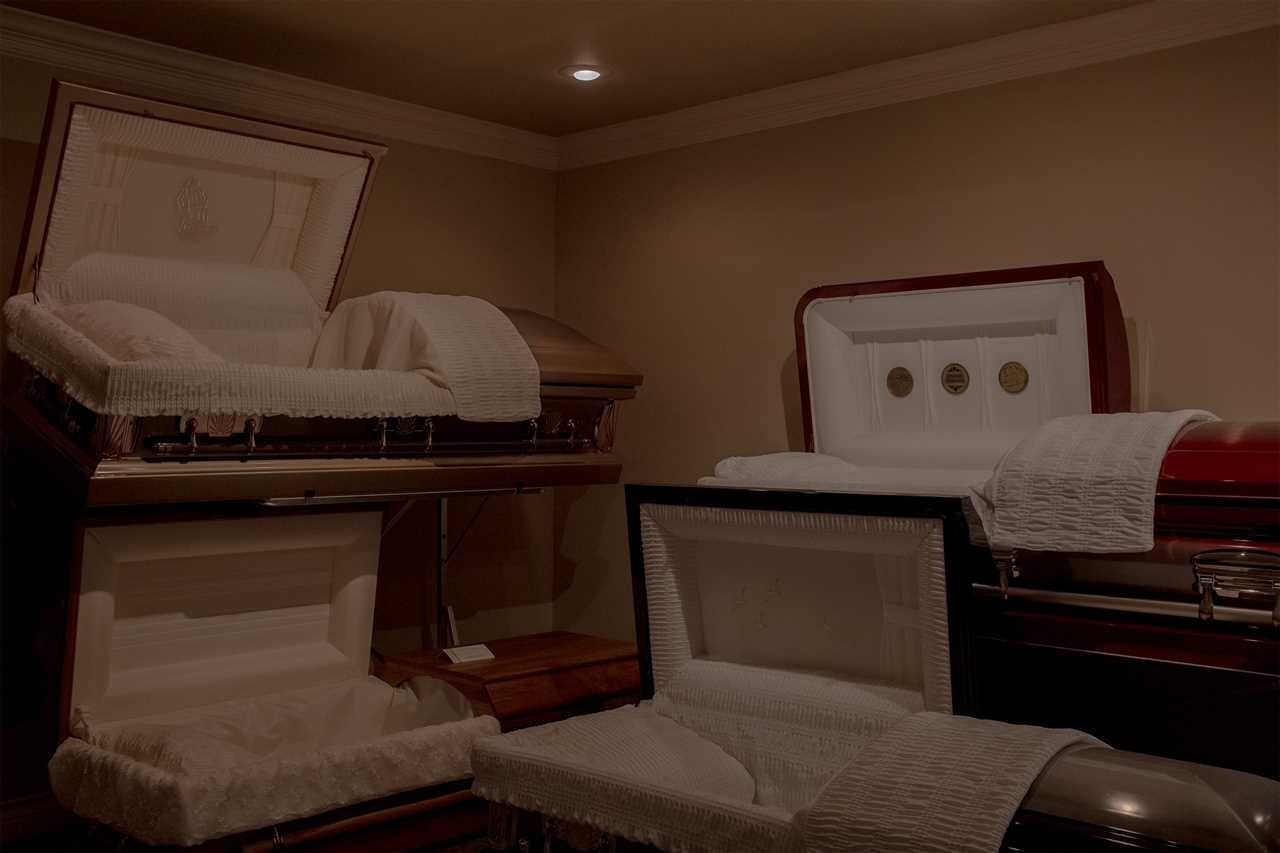
September Dawn Bottoms for TIMEMichael Ramage runs a funeral home in Olton, Texas. When his friend Chris Jones died in Dec. 2020, Ramage prepared Jones’s body. “It was the hardest one I’ve ever done, and I’ve done a bunch in 27 years,” Ramage says. “I had to leave the room a few times and have a little cry.”
Ask locals what happened here, and you get vastly different explanations. Those who had lost loved ones, or who had worked at local hospitals or funeral homes, usually said the pandemic had been devastating. “It’s right here for us,” Gary Yesel says. “You didn’t have to talk us into thinking it was real.” Others told me that the community had handled the virus quite well, and they seemed surprised when I brought up figures showing the county’s staggering death rate. The county had two local papers at the beginning of the pandemic, but both—as with so many similar institutions nationwide—were already fading, as for many residents, their Facebook feeds took the place of local media. Olton’s nearly 100-year-old paper shut down in the spring of 2022. The other, the Lamb County Leader-News, lost one of its four staff members to COVID-19 in 2022. She still hasn’t been replaced.
Many local journalists had controversial views on the virus. Phillip Hamilton, who had run Olton’s paper, told me he took the virus seriously, but he also chose not to be vaccinated, a decision he stood by even after a COVID-19 infection sent his wife Ursula to the emergency room. “I’m not a conspiracy kind of guy,” he told me in June 2022. “I just don’t think it was ever fully tested.” Another local journalist at the Lamb County Leader-News, Krista Carpenter, told me that the media had overhyped the virus. Her paper was publishing about twice as many obituaries as usual during the height of the pandemic.
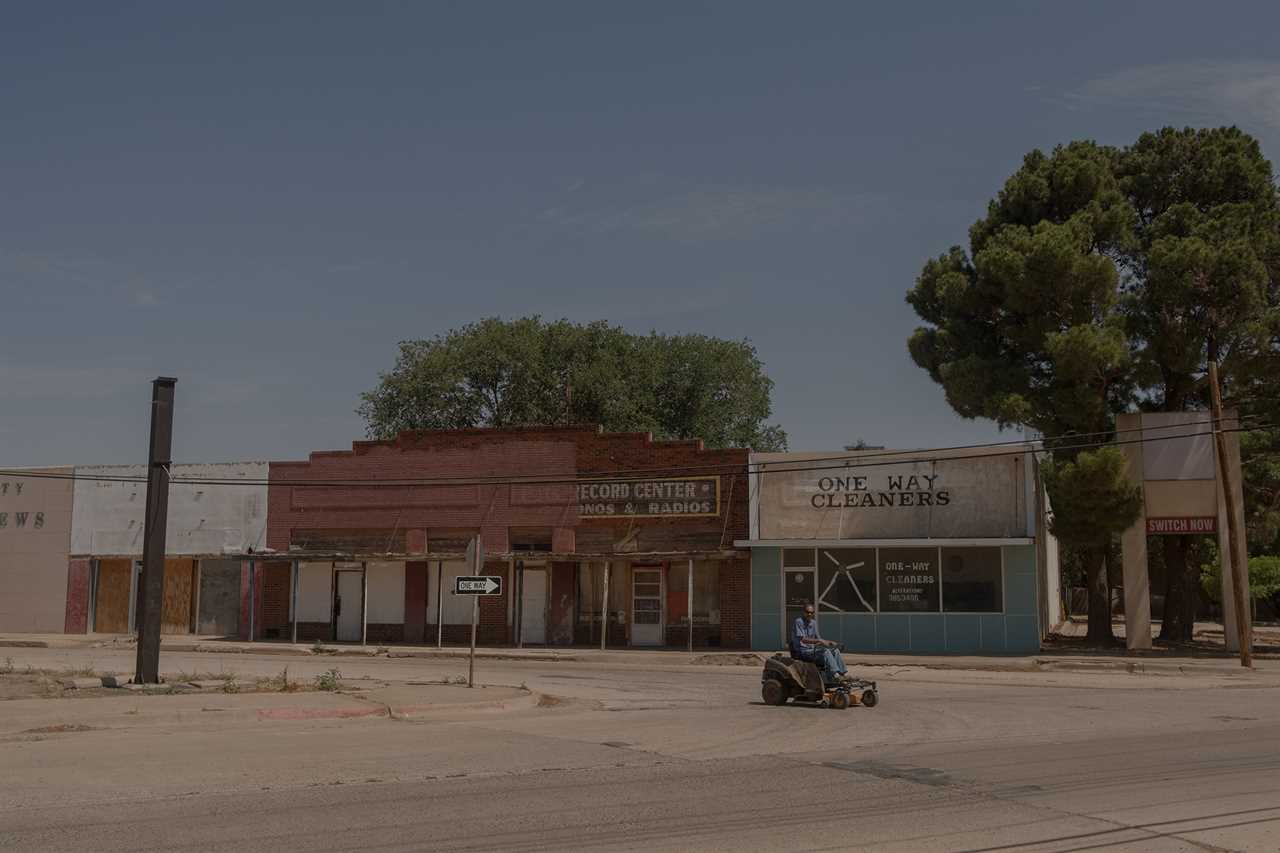
September Dawn Bottoms for TIMEAnn Reagan, 69, a stringer for the Lamb County Leader-News, remembers when downtown Littlefield was crowded with cars and people. “We’ve pretty much run out of ideas and possibilities here,” she says. “It’s happening all over the place.”
Both mask wearing and vaccines were controversial in Lamb County. Speaking to people in the region, the same phrases kept coming up in conversation: “Not going to live in fear”; “If it’s my time, it’s my time”; “Mark of the beast.” Some reported hearing advice to disregard the virus at church. Others read misinformation on Facebook. Amaya, who says he moved to Lubbock, Texas, partially to escape the life as a farmhand that awaited many Hispanic people in Olton, says Fox News plays at the power plant where he works all day, every day. “You so much as try to give a rebuttal and [my colleagues] automatically shut you down,” Amaya says. “It’s like they all share the same talking points.”
The forces that seeded those talking points have also helped to shape the government response around here. Under pressure from the far right, Texas Republican Governor Greg Abbott banned vaccine mandates in 2021. Lamb County leans heavily conservative—during the 2020 presidential election, 80% of the votes were for Donald Trump. Mike Bryant, a pastor in Lamb for much of the pandemic, says disregarding the virus became bound up in religious and political identity for many people here. “No matter where you landed on the issue, you were either shredding the Bible, or shredding the Constitution,” he says.
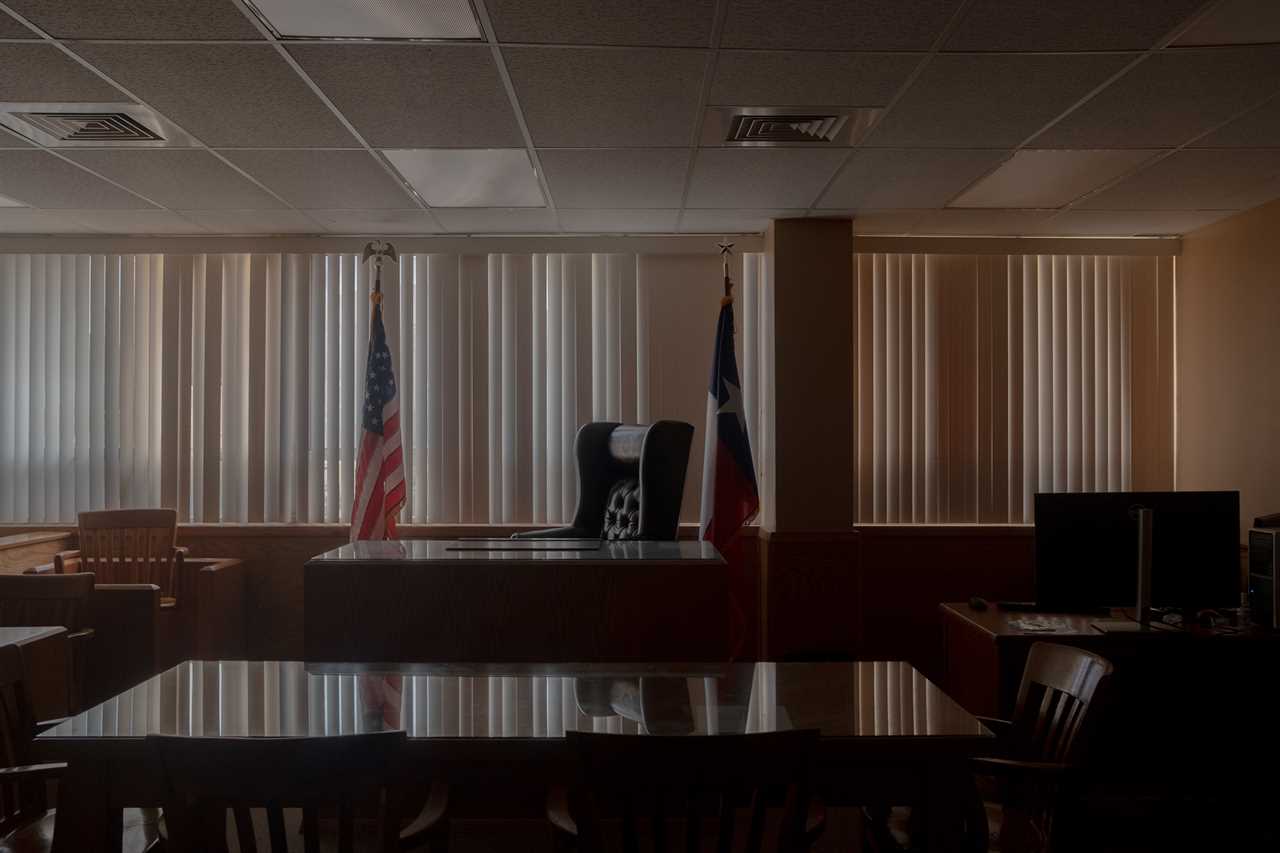
September Dawn Bottoms for TIMELamb County Judge James DeLoach says he tried to stay out of the controversy over masks and vaccines. “The state of Texas and the CDC is telling you that you need to wear a mask,” he says. “I’m giving you that information. I’ll give you a mask. You should wear it from what they’re telling me. But it’s your choice.”
Suspicion of medical guidance made its way into county government. “There’s some people that believe that the vaccine is not as much to cure disease as to possibly start another one, and then the other side thinks that we should take whatever the government tells us,” says Judge James DeLoach, Lamb’s highest elected official. “I call them both conspiracy theories.” Some Texas counties have encouraged residents to get the shots, and DeLoach got the vaccine himself, but he says he prefers not to wade into the debate. “The people in Lamb County are smart enough to make their own decision,” he says. “Do your homework. There’s a world of material out there—you read it, and make up your own mind.”
Robert Holaday, a preacher in Littlefield, says that a lot of the confusion comes down to the insular, frontier mentality that still predominates these isolated towns. The people here tend to trust local sources of information—chambers of commerce, agricultural boards, community leaders—more than any information that comes from the outside. “You’ve got all these mixed messages, and they’re coming together on social media,” Holaday says. “And so we’ve had this kind of a reaction: divided.” Rhonda Yesel says it has more to do with people in Lamb being pigheaded. “There’s an arrogant attitude around here,” she says. “People will say, ‘I’m going to defeat this.’ … [or] ‘If it’s my time, it’s my time’—you hear that so often.”
The suspicion of medical expertise isn’t limited to Lamb. The share of Americans who trust medical scientists fell from 40% to less than 30% over the course of the pandemic, according to a February 2022 Pew Research report. Among Republicans, only 15% still trust medical scientists to act in the best interest of the public. The vaccines that scientists were advocating save lives, though. One study by the Commonwealth Fund, a health care nonprofit, found that, as of August 2021, Texas could have avoided 1,900 coronavirus fatalities if it reached the same overall vaccination levels of the highest-uptake states like Vermont or Connecticut. The five states with the most effective vaccination programs had managed to vaccinate an average of 74% of their populations, compared with just 55.6% in Texas. A year later, Lamb County was far below even that state average, with just 43% of people being fully vaccinated, compared with 68% nationally as of late August 2022.
Carolyn Anderson from Spade, a small town in Lamb County, was one of those who refused to be vaccinated. She died in the summer of 2021 at the age of 78—as did two of her adult children, Travis, 53, and Michelle, 55, who lived in a neighboring county, and were also unvaccinated. All three spent a lot of time on pro-Trump Facebook pages, where pandemic misinformation was rampant. “My family died because they were too hardheaded to get a vaccine,” says Kim Carey, Anderson’s sole surviving child—and who did get the shot. “All the propaganda they were listening to was so overwhelming.”
Some people in Lamb pushed back. Linda Casares says her grandson wouldn’t get the vaccine because he read online that there was a microchip in it. In response, she took down a refrigerator magnet and rubbed it on her arm (where she’d recently gotten the shot), asking him, “Is it sticking? Is it sticking?” Holaday tried to convince his congregants to take the shot. One older man, for instance, said he wouldn’t get vaccinated, but Holaday kept bringing it up, and he asked the man’s daughter to mention it to him at home as well. “You drop an idea, drop another idea,” he says, “and wait and see who takes the bait, and runs with it as their idea.”
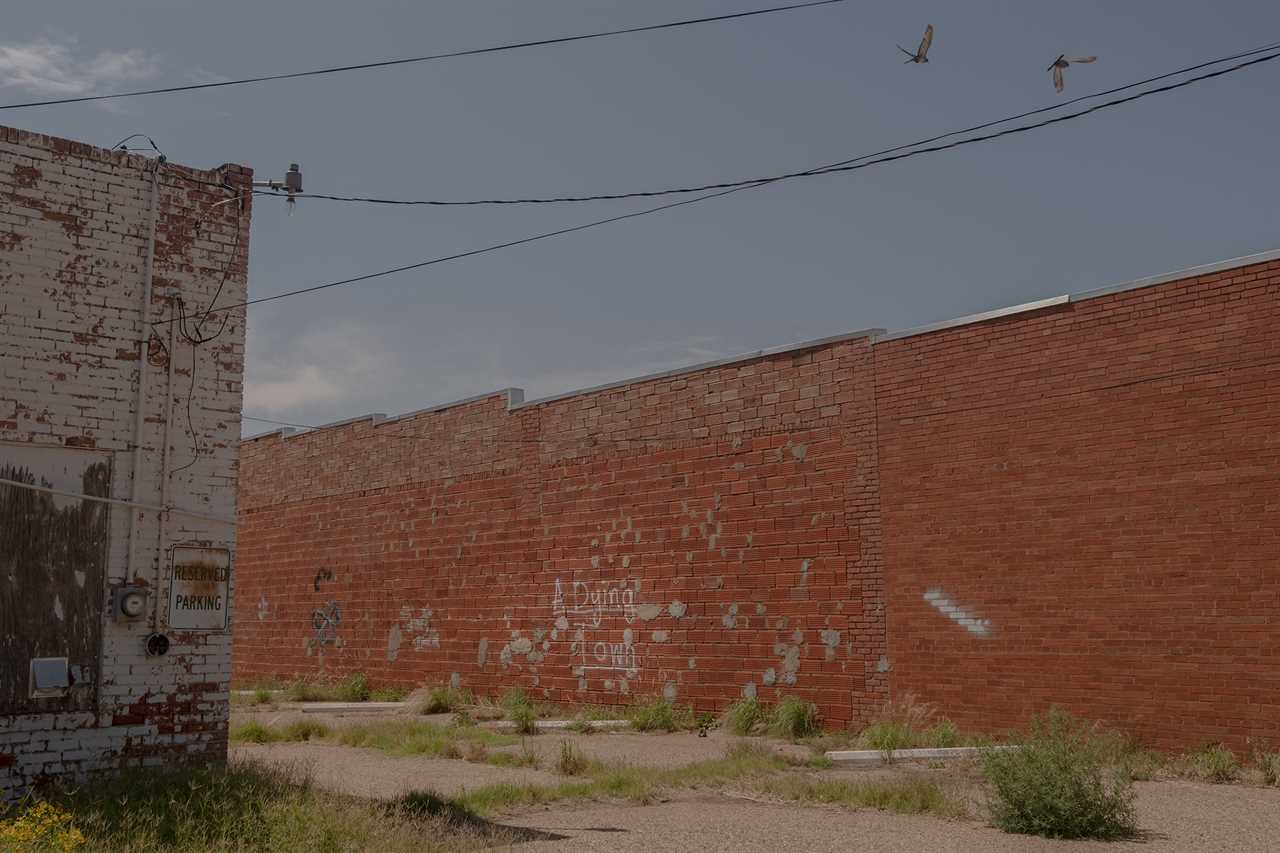
September Dawn Bottoms for TIMEDowntown Littlefield has been mostly abandoned for years. Colonies of pigeons roost in the empty buildings.
That congregant ultimately still refused to get vaccinated. Other efforts also ran into resistance. When Bryant suggested his congregants wear masks and try to stay distant from one another in the church, one of his church leaders resigned. “He said he couldn’t follow a pastor who didn’t have faith in God,” Bryant says. Some people seemed to live in a hermetically sealed information universe strong enough to overwhelm even lived experience. One woman I spoke with insisted the coronavirus wasn’t anything to be afraid of, even though her aunt had died from it.
A lot of people around the country got tired of talking about COVID-19 a long time ago. The national media has moved on to a large extent, as has the Biden Administration. But Morgan, from the National Rural Health Association, is still concerned. Uptake of the updated coronavirus boosters has been low, putting rural communities at risk for recurring waves of infection. Lingering effects from viral infection, like lung and heart damage, will likely cause yet more deaths, largely hidden even in CDC health statistics. “You still have that same older, sicker, poorer population clustered in these small towns,” Morgan says. “It’s set up for a silent crisis moving into the future.” Days before this article went to print, Rhonda Yesel contracted COVID-19 for the third time—she said it was her worst run with the illness yet. “Oxygen levels have not been above normal in several days,” she wrote over text. “Say a little prayer for me please.”
Other effects of the pandemic linger as well—a hole where loved ones used to be, and a persistent sense of confusion and injustice on the part of those who were left behind. “It just doesn’t make sense to me why my family had to die,” says Carey, crying. “I’m the only one living. I have no brother, no sister, no mom anymore.” Zamora, who lost two brothers, was infected with the coronavirus in May 2020, and she still gets so out of breath that she can hardly walk to her car from the nursing home where she works.
“Who are you going to be angry at?” she says. “At God? It’s not God’s fault.”
-----------------------------------------
By: Alejandro De La Garza / Lamb County, Texas
Title: In This Texas County, There’s No Such Thing as Moving on From COVID-19
Sourced From: time.com/6260549/lamb-county-texas-covid-19-death-grief/
Published Date: Wed, 15 Mar 2023 11:00:45 +0000
Read More
Did you miss our previous article...
https://prohealthsciences.com/general-health-and-wellness/allowing-ai-physicians-into-the-guild
 General Health and WellnessFitness and ExerciseSupplements and VitaminsPandemic NewsVideosPrivacy PolicyTerms And Conditions
General Health and WellnessFitness and ExerciseSupplements and VitaminsPandemic NewsVideosPrivacy PolicyTerms And Conditions
